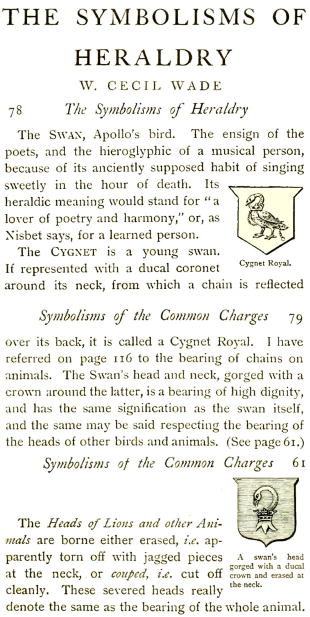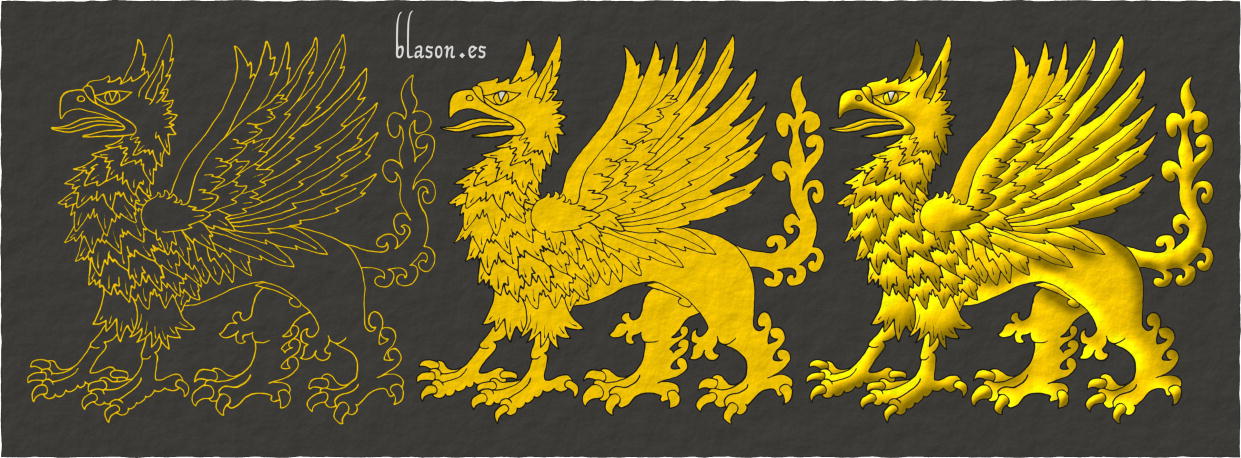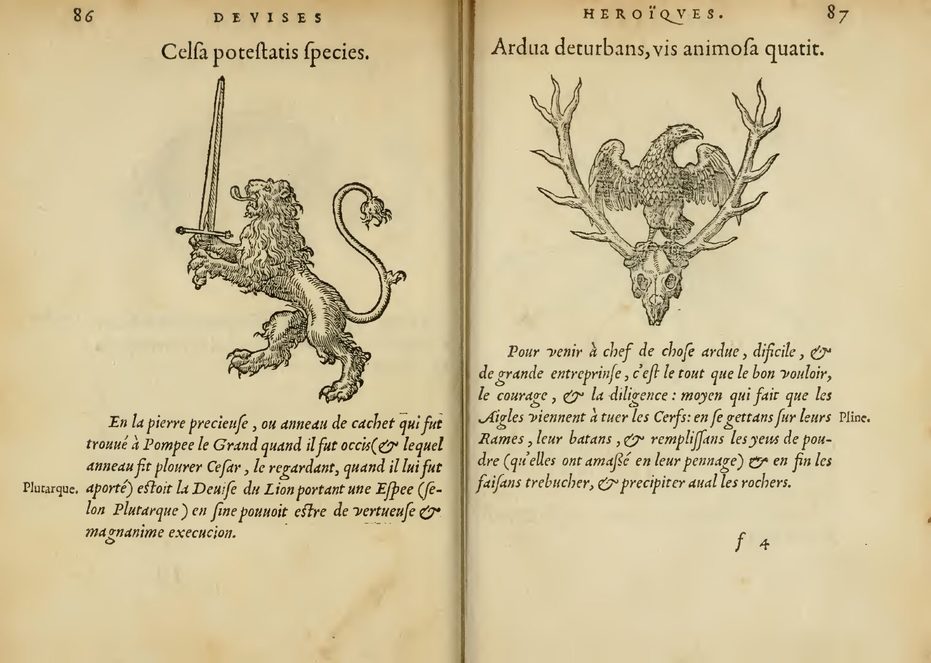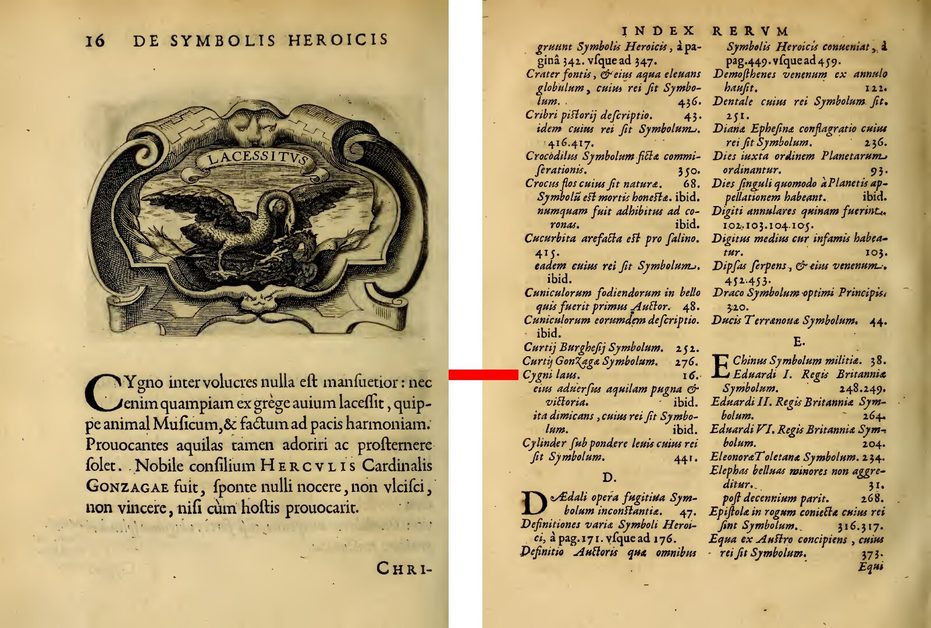Symbolism


![Ver [Bakala, K.; 2010] en referencias bibliográficas. Libro abierto, hojas de plata, filo de oro, guardas de gules, tapas de sable.](../css/Libro.Bibliografia.png)
Bakala, K.; 2010
Krzysztof Bakala, «Historia symboliczna: znakiem, herbem i barwa pisana : podreczny slownik» ~ «Symbolic history: written, emblem and color: handy dictionary», edited by Agencja Wydawnicza Egros, 198 pages, Warsaw, 2010.
Color sobre color
Sable and Purple exception on page 17: «nie pozwala nakladania metalu na metal, a barwy na barwe, za wyjatkiem barwy czarnej i purpurowej.» ~ «does not allow to put metal on metal and color on color, except the color Sable and Purpure»,
Bibliographical reference of century XXI.
Classification: Symbolism and Polish language.
The author is Bakala, Krzysztof.
Bibliographical reference mentioned in the following article:
External link:


![Ver [Conway, D. J.; 2018] en referencias bibliográficas. Libro abierto, hojas de plata, filo de oro, guardas de gules, tapas de sable.](../css/Libro.Bibliografia.png)
Conway, D. J.; 2018
D. J. Conway, «Magickal, Mystical Creatures: Invite Their Powers into Your Life», 272 pages, published by Llewellyn Publications, Woodbury, 2018.
Index of fabulous beasts
- Unicorns, page 15, including Ki-Rin, Sin-You, Karkadann, Goat-Unicorns, Winged Sea-Unicorns;
- Flying Horses, page 29, including Pegasus, Winged Sea-Pegasus, Arabian-Burak, Sleipnir, Alsvidr, Arvakr;
- Centaurs, page 39;
- Satyrs and Fauns, page 51, including Jack in the Green, Pan, Urisk;
- Gigantic Birds, in the page 63 the part I begins and in the page 71 the part II begins;
- Human-Birds, page 79, including Garuda, Tengu, Egyptian Ba;
- Griffins, page 89, including Griffin-Demons, Hippogriff, Senmurv, Simurgh;
- Mystical Bulls and Bull-Men, page 99;
- Fabulous Lions, page 105;
- Magical Serpents, page 115;
- Riddling Sphinx, page 131;
- Mad Dogs and Hell Hounds, page 137;
- Water-Folk, page 153;
- Creatures of the Stony Stare, page 183;
- Gargoyles, page 189;
- Other Magical, Mythical Creatures, page 197.
Bibliographical reference of century XXI.
Classification: Symbolism, In black and white and English language.
Author: Conway, Deanna D. J..
External link:


![Ver [Marecki, J.; 2012] en referencias bibliográficas. Libro abierto, hojas de plata, filo de oro, guardas de gules, tapas de sable.](../css/Libro.Bibliografia.png)
Marecki, J.; 2012
Józef Marecki, «Barwa w heraldyce» ~ «Color in heraldry», [Redakcja, P.; Mareckiego, J.; Rotter, L.; 2012; páginas 65-81], edited by Wydawnictwo Naukowe ~ Scientific Editorial of la Uniwersytet Papieski Jana Pawla II, 17 pages, Cracow, 2012.
Bibliographical reference of century XXI.
Classification: Symbolism, In black and white, Polish language and Article.
Author: Marecki, Józef.
Bibliographical reference mentioned in the following article:

![Ver [Paradin, C.; 1557] en referencias bibliográficas. Libro abierto, hojas de plata, filo de oro, guardas de gules, tapas de sable.](../css/Libro.Bibliografia.png)
Paradin, C.; 1557
Claude Paradin, «Devises heroïqves», with woodcuts attributed to Bernard Salomon, published by Jean de Tournes and Guillaume Gazeau, second edition, first edition published in 1551, dedication dated January 15, 1556, 261 pages, Lyon, 1557.
Description
The book includes emblems that consist of a motto, mostly in Latin, with a few in French or Greek, a woodcut illustration, and an explanation in French. The emblems feature devices of kings and rulers, symbols from the Bible, classical history, and other sources.
The title page is framed within a grotesque ornamental border. The copy includes the signature of C.F. Lüdorf, handwritten, on the lower left corner of the title page verso. There is irregular pagination with misprinted page numbers, foxing, and narrow margins. The book does not include a table of contents.
Examples of the first mottos
- Nullis praefentior aether, page 7.
- Manet insontem grauis exitus, page 9.
- Secum seret omina mords, page 11.
- Hîc ratio tentandi aditus, page 12.
- Pignora cara sui, page 13.
- Animis illabere nostris, page 14.
- Fortuna fidem mutata nouauir, page 15.
- Nutrisco & extinguo, page 16.
- Monstrant Regibus astra viam, page 18.
- Donec totum impleat orbem, page 20.
- Immensi tremor Oceani, page 22.
- Vlcus auos Troix, page 25.
- Non sine causa, page 27.
- Plus outre, page 29.
- Imperium sine fine dedi, page 32.
- Inextricabilis error, page 34.
- Securitas altera, page 36.
- Dederit'ne viam casus'ue Deus'ue, page 38.
- Fortitudo eius Rhodum tenuit, page 39.
- Non inferiora secutus, page 41.
- Ance ferit, quam flamma micet, page 43.
- Precium non vile laborum, page 44.
Bibliographical reference of century XVI.
Classification: Symbolism, In black and white and French language.
The author is Paradin, Claude.
External link:
Internal resources: ParadinC1557.DevisesHeroiqves.pdf PDF format.

![Ver [Petra Sancta, S.; 1634] en referencias bibliográficas. Libro abierto, hojas de plata, filo de oro, guardas de gules, tapas de sable.](../css/Libro.Bibliografia.png)
Petra Sancta, S.; 1634
Silvester Petra Sancta, «De symbolis heroicis», a work consisting of 9 books, published by Antuerpiae, Ex officina Plantiniana Balthasaris Moreti, 480 pages with an additional 35 unnumbered pages, measuring 21 centimeters, Liège, 1634.
Description
The title page features an engraved pictorial border, signed by Peter Paul Rubens as the painter and Cornelis Galle as the engraver. The preface is signed by Silvester Petra Sancta, a member of the Society of Jesus, dated March 1634, specifically noted as «Leodij Kal. Mart. M.DC.XXXIV», indicating that the preface was signed in Liège on March 1, 1634.
The book includes the section titled «Elogium gentis Carafaeae ac stemma procerum eius» on pages XVII-LXXX, covering topics related to the Carafa family, including 7 genealogical trees with the family's coat of arms, «Gules, three bars Argent» repeated with or without cadency marks.
This work is notable for its engravings and symbolic content, including mottos and figures. It consists of nine books, with page 479 incorrectly numbered as 749, followed by page 780, and then 5 indexes that assist in finding specific symbols, such as the symbolism of the swan on page 16.
Petra Sancta's hatching code
in the engraving on page XVI is where Silvester Petra Sancta's hatching code is best appreciated, which is the most widely used in heraldry today, with the color Gules of the field represented by vertical lines and the metal Argent of the three bars in white.
Bibliographical reference of century XVII.
Classification: Symbolism, In black and white and Latin language.
The author is Petra Sancta, Silvester.
External resources:
Internal resources: PietrasantaS1634.SymbolisHeroicis.00.pdf version 00, PDF format and PietrasantaS1634.SymbolisHeroicis.01.pdf version 01, PDF format.


![Ver [Redakcja, P.; Mareckiego, J.; Rotter, L.; 2012] en referencias bibliográficas. Libro abierto, hojas de plata, filo de oro, guardas de gules, tapas de sable.](../css/Libro.Bibliografia.png)
Redakcja, P.; Mareckiego, J.; Rotter, L.; 2012
Pod Redakcja, Józefa Mareckiego y Lucyny Rotter, «Symbol - Snak - Przeslanie: Barwy i Ksztalty» ~ «Symbol - Sign - Message: Color and Shape», edited by Wydawnictwo Naukowe ~ Scientific Editorial of the Uniwersytet Papieski Jana Pawla II, 179 pages, ISBN 978-83-7438-321-9 Cracow, 2012.
Bibliographical reference of century XXI.
Classification: Symbolism, In black and white and Polish language.
Authors:
The following article cites this bibliographic reference:
External resources:
Internal resources: RedakcjaPMareckiegoJRotterL2012.33.SymbolSignMessageColorShape.pdf PDF document in Polish.


![Ver [Wade, W. C.; 1898] en referencias bibliográficas. Libro abierto, hojas de plata, filo de oro, guardas de gules, tapas de sable.](../css/Libro.Bibliografia.png)
Wade, W. C.; 1898
William Cecil Wade, «The symbolisms of heraldry or A treatise on the meanings and derivations of armorial bearings», 186 pages, 95 black and white pictures, Robert Holmes Collection, published by George Redway, London, 1898.
Although Romanticism sought the symbolism of the heraldic elements, I believe that the meaning of the elements of the coat of arms, if they have it, is provided by its creator or first bearer. In any case, the content of this symbolic book is the following:

- The origin of armorial bearings; page 11.
- The symbolic side of heraldry; page 13.
- Heraldic colors and metals; page 35.
- The furs of heraldry; page 38.
- The meaning of heraldic lines; page 40.
- The symbolisms of the ordinaries; page 43.
- The division lines of the shield; page 55.
- The colors of the common charges not symbolical, chapter with 2 paragraphs only; page 57.
- Symbolisms of the common charges; page 59.
- Crowns, mitres, episcopal hats, etc.; page 138.
- Examples of symbolisms of colors and armorial bearings; page 149.
- Cadency and differencing; page 154.
- Alphabetic index; page 162.
Bibliographical reference of century XIX.
Classification: Symbolism, In black and white and English language.
The author is Wade, William Cecil.
Bibliographical reference mentioned in the following article:
External link:
Internal resources: WadeWC1898.SymbolismsHeraldry.pdf.
-
Language
-
Categories of heraldry
-
Divisions of the field
- Without divisions
- Party per pale
- Party per fess
- Party per bend
- Party per bend sinister
- Tierce
- Tierce sinister
- Tierced per pale
- Tierced per fess
- Tierced per bend
- Tierced pallwise inverted
- Quarterly
- Quarterly per saltire
- Gyronny
- Party per fess, the chief per pale
- Party per pale, the sinister per fess
- Party per fess, the base per pale
- Party per pale, the dexter per fess
- Chapé
- Chaussé
- Embrassé
- Contre-embrassé
- Party per chevron
- Enté
- Enté en point
- Flanched
-
Metals
-
Colours
-
Furs
-
Other tinctures
-
Ordinaries and sub-ordinaries
-
Diminutives of the ordinaries
-
Geometric charges
-
Composite ordinaries
-
Inanimate charges from Nature
Atom, Crescent, Diamond, Emerald, Estoile, Increscent, Lightning flash, Moon, Mount, Mullet, Mullet of four points, Orbital, Plough of Ursa Major, Rainbow, Ray of the sun, River, Sea, Snowflake, Sun, Sun in splendour, Sun of May, Trimount, Water and Wave.
-
Vegetal charges from Nature
Acorn, Apple, Apple tree, Ash, Bluebonnet, Camellia, Chrysanthemum, Cinquefoil, Cornflower, Dogwood flower, Double rose, Elm, Fleur de lis, Flower, Gourd, Holm oak, Hop cone, Kapok tree, Laurel, Lily, Linden, Lotus flower, Madonna lily, Mexican cedar tree, Oak, Olive tree, Palm tree, Plantain plant, Pomegranate, Poplar leaf, Rose, Shamrock, Sunflower, Thistle, Tree, Tulip, Vine and Wheat.
-
Animal charges from Nature
Badger, Bald eagle, Barbel, Barn owl, Bear, Beaver, Beetle, Bighorn sheep, Blackbird, Boar, Brach hound, Bull, Doe, Dog, Dolphin, Dove, Eagle, Elephant, Falcon, Female figure, Fish, Flame, Fly, Fox, Frog, Goat, Goldfinch, Goose, Heron, Horse, Hummingbird, Jaguar, Lark, Leopard, Lion, Lion passant, Lion rampant guardant, Lioness, Lynx, Male figure, Martlet, Merino ram, Owl, Panther, Parrot, Peacock, Pelican, Pelican in her piety, Puffin, Quetzal, Raven, Roe deer, Rooster, Savage, Seagull, Serpent, She-wolf, Stag, Starling, Talbot, Tyger, Vulture, Warren hound and Wolf.
-
Parts of natural charges
Arm, Beak, Branch, Caboshed, Chest, Claw, Covert, Dorsal fin, Eagle claw, Ermine spot, Escallop, Feather, Foot (palmiped), Foreleg, Forepaw, Hand, Head, Heart, Hoof, Leaf, Neck, Ostrich feather, Palm frond, Paw, Roe deers' attires, Shoulder, Sprig, Stags' attires, Stem, Swallow-tail, Tail, Tail addorsed, Tail fin, Talon, Tooth, Trunk, Trunk (elephant), Two hands clasped, Two wings in vol, Udder, Wheat spike, Wing and Wrist.
-
Artificial charges
Ace of spades, Anchor, Anvil, Arch, Arm vambraced, Armillary sphere, Arrow, Axe, Bell, Bell tower, Beret, Bonfire, Book, Bookmark, Bow, Branding iron, Bridge, Broken, Buckle, Cannon, Cannon dismounted, Cannon port, Canopy roof, Carbuncle, Castle, Celtic Trinity knot, Chain, Chess rooks, Church, Clarion, Clay pot, Closed book, Club, Column, Comb, Compass rose, Conductor's baton, Cord, Covered cup, Crozier, Crucible, Cuffed, Cup, Cyclamor, Dagger, Double vajra, Drum, Ecclesiastical cap, Fanon, Federschwert, Fleam, Four crescents joined millsailwise, Galician granary, Garb, Gauntlet, Geometric solid, Grenade, Halberd, Hammer, Harp, Host, Hourglass, Key, Key ward, Knight, Knot, Lantern, Letter, Line, Loincloth, Menorah, Millrind, Millstone, Millwheel, Monstrance, Mortar, Mullet of six points pierced, Nail, Non-classic artifact, Norman ship, Number, Oar, Oil lamp, Open book, Page, Pair of scales, Parchment, Pestle, Piano, Pilgrim's staff, Plough share, Polish winged hussar, Port, Portcullis, Potent, Quill, Ribbon, Rosette of acanthus leaves, Sabre, Sackbut, Sail, Scroll, Scythe, Sheaf of tobacco, Ship, Skirt, Spear, Spear's head, Stairway, Star of David, Step, Sword, Symbol, Tetrahedron, Torch, Tower, Trident, Trumpet, Turret, Two-handed sword, Wagon-wheel, Water-bouget, Wheel, Winnowing fan and With a turret.
-
Immaterial charges
Angel, Archangel, Basilisk, Dragon, Dragon's head, Garuda, Golden fleece, Griffin, Heart enflamed, Justice, Mermaid, Our Lady of Mercy, Ouroboros, Paschal lamb, Pegasus, Phoenix, Sacred Heart of Jesus, Saint George, Sea-griffin, Trinity, Triton, Unicorn, Winged hand and Wyvern.
-
External elements
-
Heraldic creations
-
References
-
Formats
-
Keywords on this page
Article, Bibliography, Colour on colour, In black and white, French language, English language, Latin language, Polish language, Century XIX, Century XVI, Century XVII, Century XXI and Symbolism.



